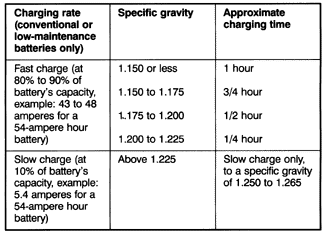4.2 Battery ChargingDischarged batteries can be recharged using a battery charger, but a battery can never be charged to a voltage in excess of that which it is capable of producing electro-chemically. During charging, the battery's voltage builds to a peak called the terminal voltage. If charging is continued beyond the terminal voltage, the water in the electrolyte begins to decompose into hydrogen and oxygen. This condition, called gassing, will evaporate the electrolyte to a level that can damage the battery. Thoroughly read the instructions provided by the battery charger's manufacturer and always follow the instructions carefully. Do not use a charger if the instructions are not available. Table e lists charging rates and times that should be followed when charging batteries.
Table e. Battery Charging Specifications
|
